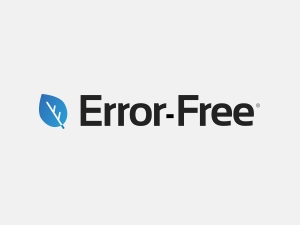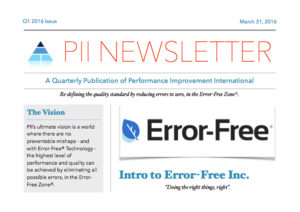Error-Free® operation and human performance can raise an organization from average to excellent in a short period of time.
Over the past 30 years, more than 50 human and organizational performance experts have worked with Dr. Chong Chiu, Founder of PII and MIT PhD, to develop technologies for one goal: Error-Free® operation and human performance. This goal has now been achieved. These new technologies have been proven to work well at many places; including, one of the largest construction firms, one of the largest nuclear operating companies, and one of the largest vaccine manufacturing companies in the world. This short paper serves to give an overview and describe the basic elements of what it means to establish Error-Free® Operations and Human Performance.
Error Free® Operation and Human Performance
Error-Free® operation and human performance mean no operational or injury events due to preventable human errors.
The concept of the error-free operation and human performance is hard to conceive, under which the operation is free of operator errors, maintenance rework, engineering design and problem solving errors, and decision errors from management. How can that be done?
Is that possible to have error free operation and human performance without prohibitive costs? The costs could be on training, setting up many barriers, or just hiring workers don’t make errors.
The short answer is yes. Two new PII technologies: (1) Predictive Quality, (2) KALETM Error-Free® Intelligence Software has made Error-Free® operation and human performance possible.
Predictive Quality
Predictive quality is a paradigm shift from reactive quality, which is largely embedded in our current management system, all the way to the other extreme end of proactive quality.
We certainly remember the management motto,
If you cannot predict, you cannot focus.
If you cannot focus, you cannot measure.
If you cannot measure, you cannot improve.
This motto eloquently summarizes the dilemma of reactive quality. Reactive quality can only rely on events and root cause analyses to find problems. It does not possess the foresight and capability to predict and prevent events ahead of time.
In the past, human errors were largely treated as a necessary evil. As a consequence, we tried to train staff how to identify and avoid error traps. Over time, employees forgot this training and fell back into habitual behavior they are used to. Another reactionary effort is to set up multiple barriers in an attempt to catch and correct errors, also known as Layers of Protection (e.g. technical review, behavior guiding procedures, etc.). Administrative staff is then tasked with setting up these barriers. However, they do so without considering their functional effectiveness and failure rates; these barriers fail miserably with time. Worse yet, when events occur, extensive and expensive root cause analyses are required. The results from these root cause analyses are often limited to teaching staff, again, with the same training they couldn’t remember initially and to writing more ineffective procedures in the same way that caused failure the first time. This event-driven reactive cycle can continue without improvement in operation for many, many years.
This sluggish improvement cycle, mentioned above, caused from reactive quality methodology can be effectively rectified. How? The answer is by shifting from reactive to predictive in quality.
The center point of predictive quality is a quantitative prediction of management system failure rates and individual human errors, about how, what, when, and where failure and error will occur.
Using a quantitative approach, human error and management failure is predicted and identified (as confirmed by past events), then allowing the critical controlling parameters affecting errors to measure to be found. Once found and able to measure, these controlling parameters can be effectively and readily improved. Moreover, after events, the predictive quality can prioritize the topics in training, improvements in barriers, and corrective actions. Based on quantitative analysis, only the most effective are chosen for implementation, leaving those least effective aside, saving time and cost.
The predictive quality process. Before we set up a barrier to prevent events, we design these barriers as we design equipment (e.g. a transformer, a turbine, etc.). We predict the failure rate and error rate that trigger events before the design and make sure they are acceptable after the design. As such, they are effective, not just in abundance, in preventing events. For workers, since we understand limitations in memory decay and tendency to make errors in certain conditions, we provide them the right information at the right time to warn them about imminent error traps and help them avoid errors.
To affect culture changes, PII has customized Error-Free® training courses; from Error-Free® Review, Error-Free® Procedure Design to Error-Free® Leadership in order to indoctrinate the predictive quality concept and its implementation process.
KALETM – An Error-Free® Intelligence Software
KALETM stands for the names of its four main modules: Knowledge, Analysis, Learning, and Error-Free®Data Bank.
KALETM is a cloud-based Error-Free® intelligence software, accessible by all devices and operating systems. This Error-Free® integrated tool provides the right information, the right check list, the right procedures, and the right analysis as a SAAS solution to help staff avoid errors or to find root causes of their errors in the most cost-effective way.
For example, KALETM can help staff avoid errors in the following ways:
- KALETM can provide e-learning on how to avoid error, on a daily basis from about error avoidance in that KALETM has one of the largest case studies library about how, when, and what errors are made and are mitigated.
- KALETM can provide e-learning in equipment reliability in that KALETM has one of the largest database about how, why, and when components could fail.
- KALETM is a cloud-based software and can provide procedures and references on an ad hoc basis, retrieved at anytime and anywhere.
- KALETM can help workers analyze themselves to their person-specific error-prone behavior
- KALETM can tell the risk of error at the pre-job-briefing based on worker-specific, job-specific, and environmental conditions.
- KALETM can audio record pre-job-briefings and analyze the readiness of the pre-job briefing.
- KALETM can help workers perform human error Root Cause Analysis and Organizational and Programmatic Root Cause Analysis through a series of Questions-Answers. Not only the analyses can be performed consistently and with high quality, KALETM can write and print out root cause reports, providing consistent and direct reporting.
- KALETM can help workers perform equipment troubleshooting through a series of Questions-Answers. After the series of Questions and Answers are answered, KALETM constructs a report for troubleshooters.
KALETM is a living system. Even though its capability and database are beyond what once seemed unfathomable, its database continues to grow and build with new events, research, analysis, and findings, regardless where they occur, in human and equipment reliability.
Benefits of Error-Free Operation and Human Performance
The ultimate vision and goal of establishing an Error-Free® operation and human performance everywhere, is to better not only individual lives in the workplace, but for humanity. The operation event rate and injury rate could go to near zero, instantly. Moreover, the operation and maintenance (O&M) cost in operation could drop significantly in the following areas:
- Repeat, unfocused error-reduction training
- Multiple barriers that should be simplified
- High event rate, each of which waste effort in management, regulatory staff, and operation staff to address
- Unneeded corrective actions, with little (or no) benefits
- Long and tedious human performance and O&P root cause analyses
- Long and tedious equipment troubleshooting
- Untimely troubleshooting in equipment or human performance issues, allowing them to progress into significant events
Knowing that even for a very standardized industry, the O&M costs of operation from company to company varies +/- 20%, largely depending on levels of human performance. Moving to an Error-Free® operation and human performance will benefit a company with a minimum of 15% O&M cost savings and will also benefit from establishing a company’s reputation as being “error free”. The speed and magnitude of O&M cost savings can be realized depending on the level of management commitment to predictive quality and Error-Free® intelligence software. We have seen fast improvement results at some organizations within a year. For a larger company, 3-5 years is a reasonable time frame to achieve that money saving goal.
With predictive quality and the KALETM, an organization can become error free, almost instantly. Before these technologies, we had to wait for significant events to occur and only then, perform root cause analyses to improve the operation. As stated before, this improvement is usually not focused and does not quantify the benefits of each factor considered. We tend to think that if we improve all areas, we will be good. This approach is burdensome. Over time, the burden we add onto the management system make companies very costly to operate. Moreover, the event-driven improvement cycle is very slow, even if it works.
Now, with predictive quality, we prevent events from the get-go and take a focused approach to improve only the few critical areas that are the most effective in establishing an Error-Free® Operation and Human Performance.
Also, with the complementary tool, KALETM, built to help predict quality, all workers can avoid and learn from errors cost effectively.






